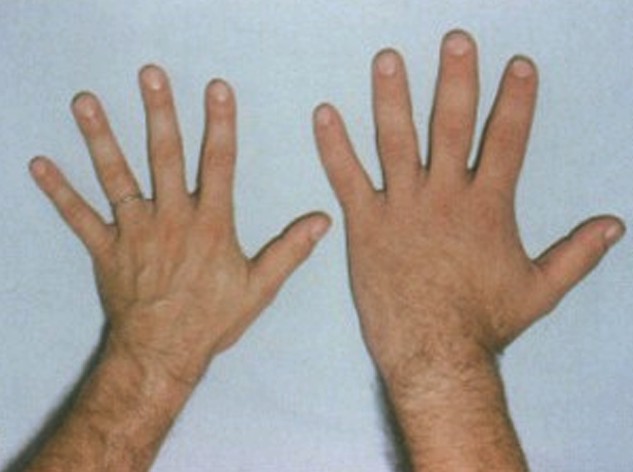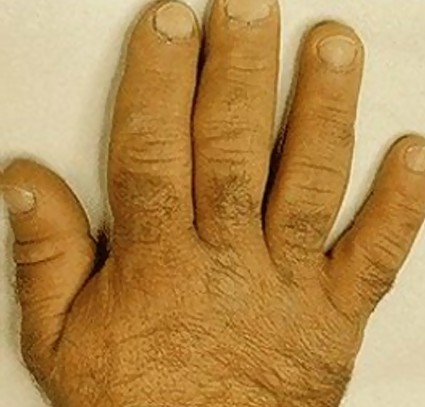What is Acromegaly?
This is a hormonal disorder that is rare and develops when the pituitary gland produces an excess of growth hormone, usually as a result of a non-cancerous – benign tumor. This hormone excess causes skin thickening, swelling, tissue growth as well as tissue enlargement, particular in the hands, feet and face.
This disease begins in adulthood, normally around middle age. With children who are in the process of growing, too much of this hormone often develops a condition referred to as “gigantism” and causes abnormalities and increases in height and excessive growth of bones.
Since acromegaly is fairly uncommon and the changes physically occur slowly, it often is not recognized immediately. Although this disease when left untreated leads to serious illnesses and even premature death, there are treatments available which can lower the risk of complications as well as significantly cause symptoms to improve.
Acromegaly Symptoms
The most common symptoms of this disease are the enlargement of feet and hands. Individuals will often notice that rings may no longer fit and that shoe width or size has increased. Back and joint pains are also common.
Acromegaly also cause changes gradually in shape of the facial area, for instance a lower brow and jaw that are protruding, a nose that is enlarged, lips that are thickened, as well as widely spacing between teeth. Since acromegaly has a tendency to progress slowly, symptoms may stay undetected for up to ten (10) years. Individuals often will not notice any changes only by comparing current appearance to older photographs.
The typical symptoms and signs of this disease include:
- Enlarged feet and hands
- Lower jaw protrusion so that the lower teeth extends pass the upper teeth – known as an under bite
- Broader and larger facial features
- Thick skin that is very oily
- Excessive sweating as well as excess body odor
- Muscle weakness and fatigue
- Skin outgrowths or skin tags that are small
- Husky, deepened voice due to vocal cords and sinuses that are enlarged
- Severe snoring as well as frequent very short interruptions in breathing during the night (sleep apnea) due to swelling of tissue that blocks upper airway.
- Headaches
- Impaired vision
- Tongue that is enlarged
- Back pain
- Limited and painful mobility in joints
- Irregularities in women’s menstrual cycle
- Sex drive that is reduced and in men, trouble achieving or maintain an erection (erectile dysfunction)
- Enlarged heart, liver, spleen, kidneys as well as other organs
- Increased size in the chest or barrel chest
If an individual notices any long-term changes in appearance or other symptoms that might be linked with this disease, contact the primary care physician.
Acromegaly normally grows slowly and even individual family members might not notice initially the gradual physical changes that have occurred. A timely diagnosis is extremely important, so that proper care can be received as quickly as possible. This disease may lead to very serious complications especially when it is not treated.
Acromegaly Causes
This disease of acromegaly develops when the body creates too much hormone for growth. This excess hormone source is almost in every case the pituitary gland that is a small bean-shaped structure behind the nose at the brain base. Hormone growth is one of many hormones that the pituitary gland produces.
Hormone for growth plays a role in regeneration and growth of the bones that is very important in stimulating additional tissues by stimulating the liver to generate another hormone referred to as “insulin-like growth factor-I” or IGF-I.
In adults, a tumor is normally the most common reason of excess hormones for growth:
Tumors Pituitary
Most cases of acromegaly are developed by a non-cancerous or benign tumor, or adenoma of the pituitary gland. Additionally in order to produce excessive growth hormone, these tumors may press on nearby tissues as they are growing. This pressure can cause some of the acromegaly symptoms, for instance impaired vision and headaches.
Tumors Non-pituitary
In a small group of individuals, this disease is developed by cancerous or benign tumors in other areas of the body, for instance the pancreas, lungs or adrenal glands. There are some of these tumors that actually develop growth hormone. In additional cases, they generate a hormone called GH-RH which triggers the pituitary gland to generate further growth hormone.
Acromegaly Diagnosis
As a beginning step toward diagnosis, the physician will first take a complete history medically and also conducts a physical exam. Then she or he will advise the following tests:
http://www.Symptoms-Causes-treatment.blogspot.com detect diseases at an early stage symptoms, and find out the causes and treatments best suited.
Measuring IGF-1
Since growth hormone triggers the liver to produce IGF-1 – which is another growth hormone – then levels of IGF-1 in the blood are elevated nearly always when an individual has acromegaly.
Measuring growth hormone prior to and after drinking glucose
The physician will also test the levels of growth hormone to have a confirmation that this individual has acromegaly. With this test, the levels of growth hormone in the blood are measured both prior to and at different points after drinking a sugar preparation (glucose). With a normal test, taking in glucose will cause levels of growth hormone to fall. But if the body is generating too much growth hormone, the levels will stay high.
Imaging
After this disease has been diagnosed by lab testing of IGF-1 and growth hormone levels, the physician will more than likely recommend an MRI of the brain to pinpoint the location and size of any tumor. Brain imaging can also be performed with CT scans. If brain imaging fails to find a pituitary tumor, the physician might recommend more blood work as well as further imaging studies of the abdomen or chest.
Acromegaly Treatment
Physicians treat this disease caused by tumors that are benign of the pituitary gland with surgery, radiation and medications. The plan for initial care will depend on your age, the location, and the size of the tumor as well as other medical problems the individual might have.
As time goes by, the individual might need additional treatment. The goal of any therapy is to normalize the growth hormone and IGF-1 levels as closely to normal as possible in order to avoid any complications that are serious and eliminate any risk of premature death. With treatment that is successful, enlargement and swelling of the soft tissues can gradually subside. Treatment cannot reverse any excess bone growth, but it can prevent more excess growth from occurring.
If acromegaly is caused by any tumor outside the pituitary gland, the physician will develop individualized treatment plans based on the location of the tumor as well as whether it is cancerous or benign.
Acromegaly Surgery
Physicians may remove most tumors of the pituitary gland using transsphenoidal surgery. This is a technique, named for the sphenoid sinus – a pocket of air behind the nose – the surgeon will extract the tumor thru a very small incision thru the back nasal wall.
Since transsphenoidal surgery is fairly complex, it is important to find a surgeon who has experience in performing these procedures. Most research has shown that the more-experienced surgeons who have performed a larger number of procedures usually have more outcomes that are successful.
Removing any tumor surgically may effectively and quickly return hormone levels to normal as well as relieve any pressure on the tissues surround the pituitary gland. But even the best and more experienced surgeon may not be able to totally remove tumors that have grown large or that extended into the nearby blood vessels or other structures. Tumor removal that is incomplete can cause growth hormone levels that remain high after surgery, therefore requiring further treatment with radiation or medication.
Acromegaly Medications
Physicians might decide to manage an individual acromegaly with drugs especially when the pituitary tumor is surgically unreachable or if the individual is at a high risk of complications from the surgery. This need for medications might continue for the remainder of a person’s life.
Radiation
The physician might recommend treatment with radiation if cells of tumors remain post-surgery and if medication is not effective in reducing the level of growth hormone.
After treatment for this disease, individuals will need to be continually monitored by a physician in order to make certain that the pituitary gland is functioning correctly and that the symptoms are getting better. This follow-up monitoring might last the remainder of a person’s life. Since acromegaly is linked to risks of colon polyps that are pre-cancerous, screening colonoscopy need to be done close to the time of the diagnosis and at regular intervals after.
Acromegaly Pictures


